|
|
|



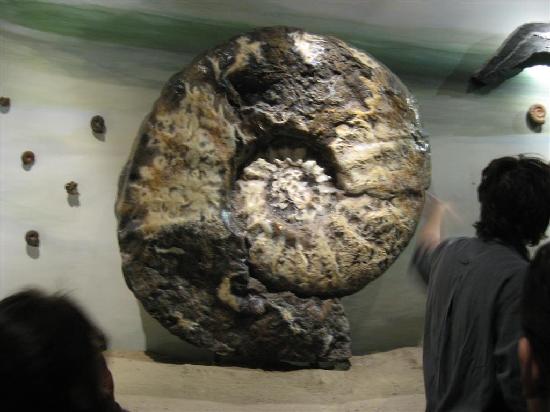
| Hot-blooded/Cold-blooded Debate Hot-Blooded
or Cold-Blooded?. Evidence presented on this site pertains to dinosaur
physiology. After a quick review of what has transpired in the last few
decades, the reader is asked to form an opinion on what dinosaurs were
like. Were they sluggish and stupid as the old conventional wisdom
said, or were they mammal or bird-like as in Jurassic Park? Or can we
even be sure what they were like? After a few preliminary warnings and
some definitions, links take the reader to evidence for and against
endothermic or ectothermic dinosaurs. A third link takes the reader to
a review of current hypotheses. |
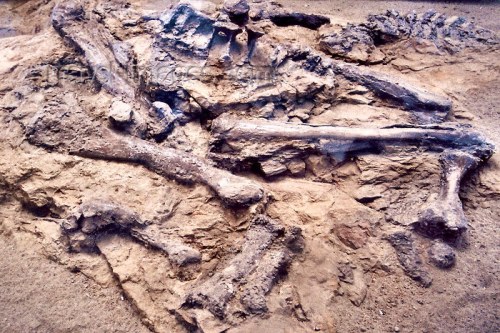
In
the early 1970s, Robert T. Bakker drew on the work of anatomist Gerhard
Heilmann and paleontologist John Ostrom and argued that dinosaurs were
not slow moving, but rather warm-blooded, active, and mobile. He also
argued that dinosaurs are the direct ancestors of birds, a theory that
received further support with new discoveries in the 1990s. |
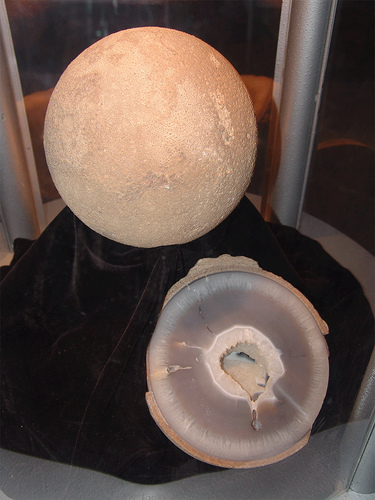
| Dinosaur - History Of Eggs Dinosaurs
are extinct (apart from their descendants the birds) and their eggs are
represented today as fossils, in particular trace fossils. Trace
fossils of dinosaurs are marks or indicators preserved in the rocks
left by the particular vertebrate at a particular time. Other trace
fossils include. They represent that product of egg laying activity and
can offer clues to how dinosaurs behaved. |

The eastern half of North America has
produced few dinosaur fossils. In the 1980s, Paul E. Olsen studied the
East Coast from Nova Scotia to New Jersey. He discovered the remains of
several new Triassic dinosaurs. Olsen also found evidence of a large
asteroid impact near the end of the Triassic, which may have killed
other animals and allowed dinosaurs to rise to dominance. |
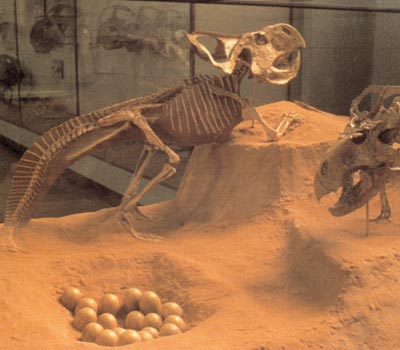
The
dinosaur eggs went through a series of major events to become known to
us today as fossils. After being laid, the egg was buried by a fine
covering of sediment (maybe sand). This protected it from predation and
scavenging and sealed it from the air (in particular oxygen) which
would break it down and destroy the egg. Ground waters flowing through
the sediment go through the egg and minerals precipitate from the
solution into the egg.The original shell material is actually little
altered during fossilization as it is made up of the mineral calcite
which is stable (resistant to change) during the fossilization process,
although it may be recrystallised. This outer shell is hard and made up
of a series of interlocking units, a mosaic of plates, with pores which
allow the passage of air in and out of the egg. This allows the baby to
breathe. |
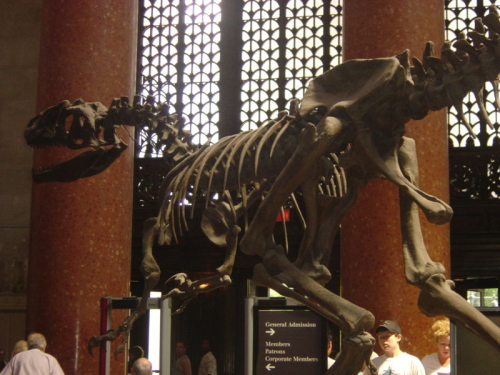
The
inside is not preserved during fossilization (apart from some rare
dinosaur babies).However,there are some clues to what the inside of the
eggs looked like. By looking at the nearest living relatives of
dinosaurs today, such as the birds and crocodiles, we can estimate to
what the inside of dinosaur eggs looked like.Housed inside the egg is a
thick or viscous liquid which bathes the embryo and keeps it moist,
preventing it from drying out. This allows the egg to be laid on land
and is a feature of animals called amniotes - all reptiles, birds and
mammals. Amniotes can live on land due to this amniotic membrane,
whereas amphibians do not have this ability and are restricted to the
water to lay eggs. |
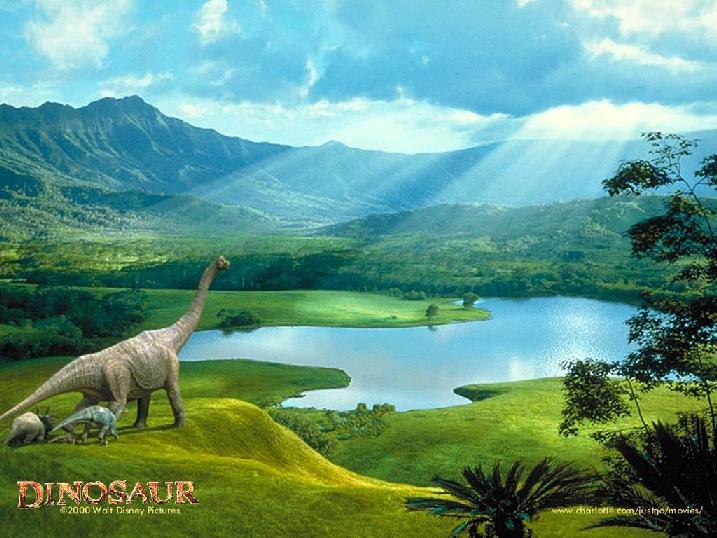
Dinosaur
eggs have been known for thousands of years, although at first they
were not recognized as 'dinosaur eggs' and were used for jewellery and
shaping ornaments. Many eggshells were found in late Palaeolithic or
early Neolithic sites in Mongolia.The first real discovery of dinosaur
eggshell was in 1859 from southern France, by Jean Jacques Pouech. The
French eggs were thought to belong to giant birds at first, because of
their large size. More complete eggs were found in 1869 by Matheron. He
thought these eggs belonged to a giant crocodile. In 1877 Paul Gervais
(1816-79) published the first detailed study of the eggs, and suggested
that they could belong to a dinosaur. They are now known to have been
laid by the sauropod dinosaur Hypselosaurus.In 1923 the Central Asiatic
Expeditions of the American Museum of Natural History made significant
new discoveries in the Gobi Desert, Mongolia. Roy Chapman Andrews found
the first recognized dinosaur nests. The eggs were thought at that time
to belong to Protoceratops but are now known to belong to Oviraptor. |

Protoceratops
andrewsi was discovered in Mongolia in 1922 by an expedition from the
American Museum of Natural History led by Roy Chapman Andrews. Its
genus name means "first-horned face," and its species name was in honor
of the expedition's leader. Protoceratops is one of the most celebrated
dinosaurs of the 20th century. Workers also discovered the skeleton of
a nimble toothless predator that was later named Oviraptor
philoceratops, which means "egg-stealer, lover of ceratopsians." In the
Gobi Desert were parents, nests, eggs, hatchlings, and egg stealers all
in one amazing deposit. This was the first discovery of dinosaur eggs,
and the discovery made news everywhere. |
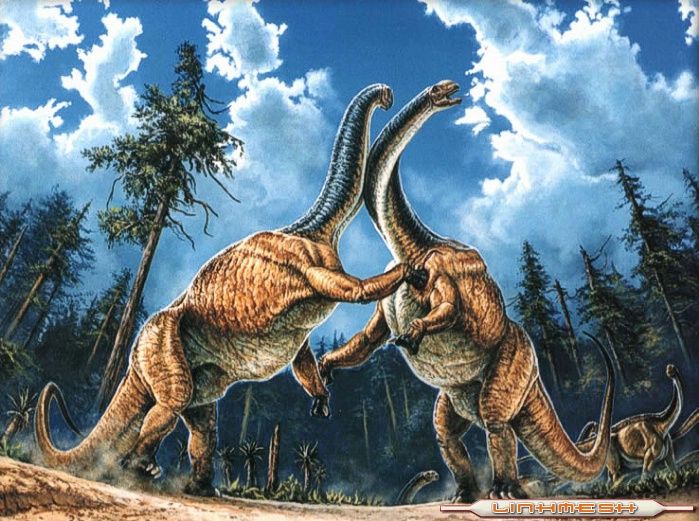
Protoceratops
may be the ancestor of all horned dinosaurs. Because of this
evolutionary link, and because of all the fossils found, it has been
the subject of much study. Like all ceratopsians, Protoceratops was
from the Late Cretaceous, but it was older than most of its relatives. |

Protoceratops
was a small, compact dinosaur, only six feet long as an adult and two
feet tall at the hips. It weighed less than 400 pounds. Hatchlings were
only a foot long, and the eggs were eight inches long and seven inches
around. Although small as adults, Protoceratops had a sturdy build. The
front legs were nearly as long as the back, so it could carry its heavy
head and jaws. Its toes had claws that it used to dig in low vegetation
for leaves and twigs. Its heavy tail balanced the animal when it walked. |
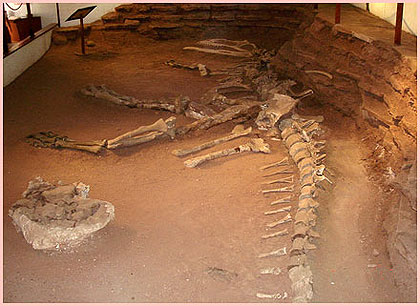
It
had a parrotlike beak that was rounded and toothless. The rear of the
skull was expanded into great ridges of bone where the jaw muscles
attached. The bony frill was small and simple in Protoceratops but
became large and elaborate in some of its giant relatives. The sides of
the frill were open, which lightened the skull without losing strength.
The frill extended well past the neck joint. For a small dinosaur, the
head and jaws were enormous. Because of this weight, the animal needed
to walk on all four limbs so it could support its head when it walked. |
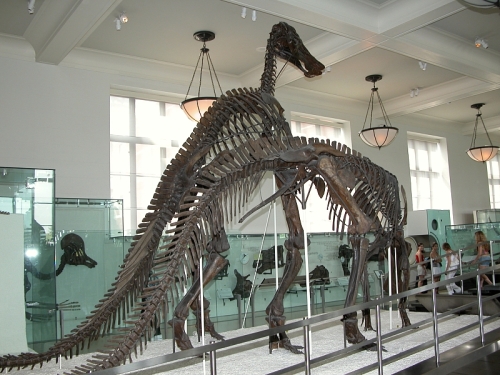
Protoceratops
had a powerful bite; it cropped low vegetation with its beak. Behind
its beak, it had dozens of teeth that chopped the tough leaves and
branches into smaller pieces, perhaps in a chewing motion. Food
collected in its fleshy cheeks on the sides of the jaws. Along with
low-growing shrubs and trees, Protoceratops may also have eaten the
newly evolving angiosperms (flowering plants) that appeared in the Late
Cretaceous. Protoceratops
did not have horns on its face or a shield like those found on its
relative Triceratops. Protoceratops did have a slight bump on the snout
below the eyes. It may have been the beginning of a horn. The bump was
larger on males, which also had larger frills. Males may have used
these features to attract females. With the discovery of so many
skeletons, scientists concluded that Protoceratops lived in herds. |
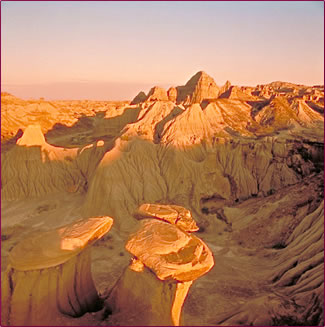
A
surprise for paleontologists was the discovery that these dinosaurs
lived in the desert. The eggs were laid in shallow holes in the sand.
Also, the small pores and the pattern on the shells show that the eggs
were adapted for desert conditions. In the 1920s, scientists thought
that all dinosaurs lived in swamps and forests. Relatives
of Protoceratops included Montanaceratops and Leptoceratops from North
America, and Bagaceratops and Microceratops from Asia. All are from the
Late Cretaceous and are quite similar to their more famous cousin.
There may have been land connections between the northern continents in
the Late Cretaceous that allowed these small ceratopsians to migrate. Another
group of primitive ceratopsians, the psittacosaurs, also had a beak and
lived earlier than Protoceratops and its relatives. Psittacosaurus was
also found in Mongolia by the Andrews expedition. The psittacosaurs may
have been the ancestors of Protoceratops. |


